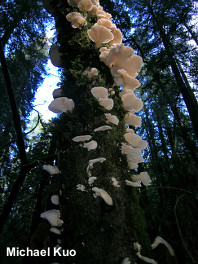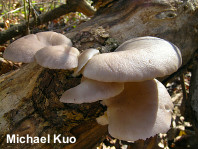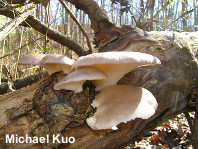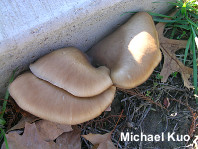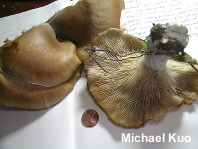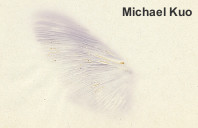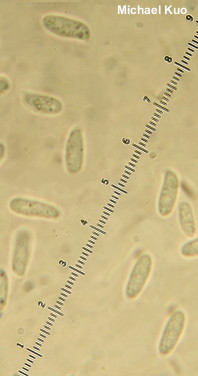| Major Groups > Gilled Mushrooms > Pale-Spored > Pleurotoid Mushrooms > Pleurotus ostreatus |

|
Pleurotus ostreatus [ Basidiomycota > Agaricales > Pleurotaceae > Pleurotus . . . ] by Michael Kuo Pleurotus ostreatus is easily recognized by the way it grows on wood in shelf-like clusters; its relatively large size; its whitish gills that run down a stubby, nearly-absent stem; and its whitish to lilac spore print. It appears between October and early April across North America, and features a brown cap. A number of very similar species are closely related, including Pleurotus pulmonarius (which is often paler, and appears between late April and September), and Pleurotus populinus (which is found on the wood of quaking aspen). Although the physical features of Pleurotus ostreatus are not always enough to separate it from closely related species, it is a "good species" by virtue of its DNA and its inability to mate with other species. Thus, while its cap is often darker brown than the caps of Pleurotus pulmonarius and Pleurotus populinus, there is substantial overlap, especially when faded specimens are considered; the cold fruiting season and the kind of wood (not quaking aspen) make for better separators. I think Pleurotus ostreatus and other "oyster mushrooms" have a peculiar smell, but I would be hard pressed to describe it. An "oyster mushroom smell" is about all I can come up with, but the not-unpleasant odor seems fairly distinctive in the mushroom world. Pleurotus ostreatus attacks and kills nematodes and bacteria with impunity; just search the Internet with "pleurotus nematode" to see photos, and even videos, of this fascinating phenomenon. For fungal fans, this is the equivalent of watching lions kill gazelles on the Nature Channel. And now, as a science-based author, I'm forced to say a few things that will be unpopular in some unscientific circles. Pleurotus ostreatus is not going to cure your cancer, nor any other ailment you have; it is not going to rid the planet of pollution or clean up toxic waste sites through "mycoremediation"; it is not going to purify your water through "mycofiltration." These and similar ideas are pseudoscience, with no legitimate scientific support, peddled by various folks and unfortunately recounted in bad science reporting and in the alternative health media. Description: Ecology: Saprobic; growing in shelf-like clusters on dead logs and living trees (primarily hardwoods, but sometimes on conifers); causing a white rot; late fall (October) through early spring (early April); common; widely distributed in North America. The illustrated and described collections are from California and Illinois. Cap: 3–15 cm across; broadly convex, becoming flat or shallowly depressed; kidney-shaped to fan-shaped in outline, or nearly round if growing on the tops of logs; somewhat greasy when young and fresh; bald; pale to dark brown; fading to buff; sometimes fading slowly and becoming two-toned; the margin somewhat inrolled when young. Gills: Running down the stem (or pseudostem); close; short-gills frequent; whitish or with a gray tinge, becoming yellowish in age and sometimes developing brownish edges; often filled with black beetles, in my collecting areas. Stem: Usually rudimentary and lateral (or nearly absent) when mushrooms are growing from the sides of logs or trees, but sometimes more or less central when growing on the tops of logs or branches; 1–7 x 1–3 cm; whitish; hairy to velvety; tough. Flesh: Thick; white; unchanging when sliced. Odor and Taste Odor distinctive but hard to describe (see above); taste mild. Chemical Reactions: KOH negative on cap surface. Spore Print: White to faintly yellowish, or lilac. Microscopic Features: Spores 7–11 x 2–4 µm; cylindric-ellipsoid; smooth; hyaline in KOH; inamyloid. Basidia 4-sterigmate. Hymenial cystidia not found. Pileipellis a partially gelatinized, tangled cutis of elements 2.5–10 µm wide, smooth, hyaline to yellowish in KOH, inconspicuously clamped. REFERENCES: (Jacquin, 1774) Kummer, 1871. (Fries, 1821; Saccardo, 1887; Kauffman, 1918; Smith, 1975; Smith, Smith & Weber, 1979; Weber & Smith, 1985; Arora, 1986; Barron & Thorn, 1987; States, 1990; Phillips, 1991/2005; Lincoff, 1992; Metzler & Metzler, 1992; Guzman et al., 1994; Petersen & Krisai-Greilhuber, 1994; Vilgalys & Sun, 1994; Zervakis & Balis, 1996; Vilgalys et al., 1996; Barron, 1999; Mansur, 2003; Roody, 2003; McNeil, 2006; Miller & Miller, 2006; Kuo, 2007; Binion et al., 2008; Kuo & Methven, 2014; Desjardin, Wood & Stevens, 2015; Siegel & Schwarz, 2016; Woehrel & Light, 2017; Petersen et al., n. d..) Herb. Kuo 12080101, 03150301, 10310702, 11010906, 11181301. This site contains no information about the edibility or toxicity of mushrooms. |
© MushroomExpert.Com |
|
Cite this page as: Kuo, M. (2017, December). Pleurotus ostreatus. Retrieved from the MushroomExpert.Com Web site: http://www.mushroomexpert.com/pleurotus_ostreatus.html |
